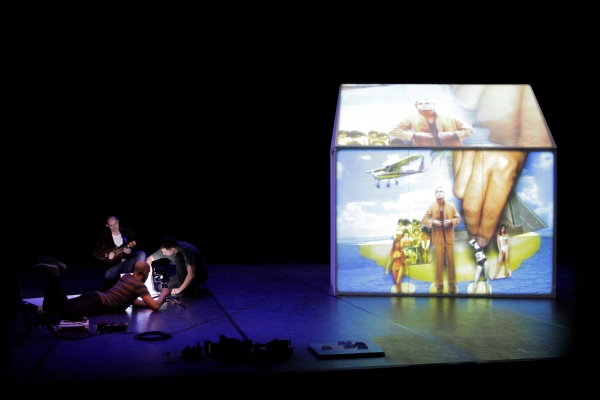Brickman Brando Bubble Boom

(© Alfred Mauve)
What does Marlon Brando have to do with the 2008 subprime mortgage crisis? Spain's Agrupación Señor Serrano will tell you with Brickman Brando Bubble Boom, now playing La MaMa's Ellen Stewart Theatre as part of the Under the Radar Festival. The company is the namesake of multimedia-entrepreneur-turned-stage-director Àlex Serrano. With the help of Pau Palacios, sound operator Alberto Barberá, and actor Jofre Carabén (the only one of the four who speaks during the show), Serrano jumps across time and space to make unlikely connections, some surprisingly thoughtful, others half-baked. Still, this show is worth seeing simply for the extreme level of skill and craft on display.
There are three major parts to this show, distinguished by a confusing array of "chapters" and "rounds." One part tells the rags-to-riches story of Sir John Brickman, a Victorian builder who, we are told, invented the mortgage system. Another part recalls the similarly hardscrabble childhood and opulent adulthood of American actor Marlon Brando. Both are used in an attempt to explain the third part: the collapse of the housing bubble, an event that hit Spain particularly hard. According to Agrupación Señor Serrano, 300,000 Spanish families have been evicted from their homes since 2008. How could such a spectacularly disruptive thing have been allowed to occur? Señor Serrano has some ideas.
"Soy Brrrrrrickman," Carabén announces dramatically, dubbing over video of Brando as Mark Antony in Julius Caesar. (Several of Brando's films are used to tell Brickman's story, with English subtitles that do not at all correspond to the original dialogue.) The company repurposes Antony's "Friends, Romans, Countrymen" speech as Brickman's appeal to the people of England that they all deserve houses and cars and plasma-screen TVs. A conspiratorial online chat between representatives of government, finance, industry, and the press explains how credit was loosened to allow them to buy those things they couldn't actually afford. The wily Brickman conducts all, like a nefarious maestro.
In reality, we'd be hard-pressed to identify such a convenient and singular boogeyman as this Victorian Citizen Kane knockoff. But what Agrupación Señor Serrano lacks in subtle economic analysis (and who wants a theater troupe to excel in that anyway?), it more than makes up for in its distinctive and awe-inspiring style.
Video projection has become de rigueur in the theater. Yet where most shows prerecord, Agrupación Señor Serrano creates many of its projections live using incredibly detailed miniatures (beautifully designed by Nuria Manzano). They tell the story of Brickman's impoverished formative years with a tiny Dickensian slum fashioned out of cardboard and clay. We learn about Brando's private island paradise of Tetiaroa through a series of paper dolls. Serrano shoots close-ups as Palacios deftly moves the necessary props in and out of the frame. This path-of-most-resistance approach to live filmmaking is simultaneously stressful and breathtaking to behold.
For indeed, there is just so much that could go wrong in the process — so much left to the fickle whims of technology. This extends to their larger-scale creations. Rather than a set designer, they have an architect (Pau Vidal). The performers use several large Styrofoam boards to build the set (a giant Monopoly house) before our very eyes. When they pull it off, it's kind of like watching an Olympic gymnast stick a perfect dismount. The performers attempt to mask their extreme tension with a feigned Spanish sangfroid, but it's impossible not to sense their nerves, even when they're dancing around to funky music and grinning widely (all the while glancing over their shoulders to make sure the projection is still working).
All of this leads to a cynical conclusion that feels like a punch to the gut of our American mythology of wealth and happiness (and the self-importance of the arts). Brickman Brando Bubble Boom may lead you to run out of the theater and join the Indignados, or it may make you raise an eyebrow in skepticism. Either way, it's a DIY spectacle not to be missed.










